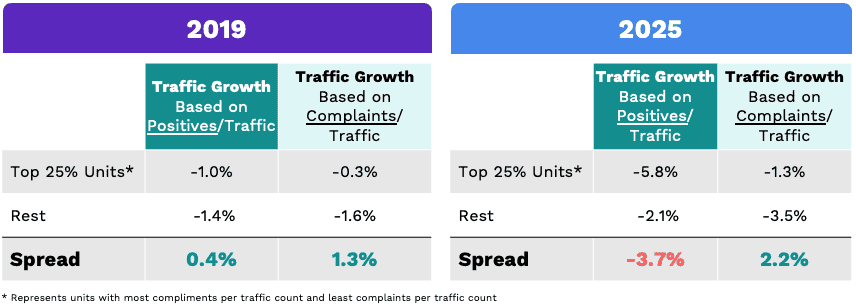September 2025 Monthly Second Helping: Highlighting Hot Topics in the Industry
What BBI Data Says About: Why Your Amazing Star Rating Isn’t Resulting in Traffic
Black Box Intelligence analysts are often asked by baffled restauranteurs, “if my Average Star Rating is improving, why isn’t my traffic?”
It’s a legitimate question given that Black Box Intelligence continues to emphasize the importance of review data (and indeed – the data, for the most part, reinforces this point).
So if review data is so important, why are some brands getting great reviews but poor traffic? Let’s try to answer this riddle.
Reasons for the Financial and Online Rating Discrepancy
The first and most obvious explanation is, while there is a correlation between the star rating the guest sees and financial performance, this relationship is not one-to-one. There are always many factors at play such as the restaurant’s location, proximity to competition, bad weather, economic considerations, and a myriad of other possibilities.
The second is that improving the average star rating that someone sees when searching google takes a long time. The average star rating seen on google is the aggregation of the unit’s lifetime, so while getting better reviews for a quarter or two is great, it will likely take a longer period of sustained improvement before it’s noticeable on a google search.
Finally, and perhaps most interestingly, how you are improving your star ratings matters. Not all improvement is the same. The increase in and heightened focus on review solicitation in recent years has further complicated this relationship.
Accentuating the Positives Is Good, Reducing the Negatives Is Better

Source: Black Box Intelligence Restaurant Performance Network
When we examine our extensive restaurant performance data network and adjust the number of compliments (positive review feedback) and complaints (negative review feedback) to traffic volume (i.e. compliments/complaints per guest), we see the effect of this review solicitation.
In 2019, the top 25% of units with the highest frequency of positive comments normalized for traffic (the most compliments per customer) had 0.4% better traffic than the rest of units. Which is great. What unit would turn away 0.4% more traffic?
However, that same year, the top 25% of units with the lowest frequency of negative comments adjusted for traffic volume (i.e. the least complaints per customer) had 1.3% better traffic than the rest.
In 2025, that gap widened. The 25% of units with the most compliments per customer actually had -3.7% worse traffic growth than the rest of the system. Meanwhile, the 25% of units with the least complaints per customer had 2.2% better traffic than the rest of the system.
This is almost certainly a consequence of review solicitation. When restaurants encourage guests to leave a review, what typically happens is an increase in positive sentiment. Even though this is likely not the intention from the restaurant, restaurant staff are more likely to naturally have a better interaction with guests that have had a positive experience at the restaurant.
This then leads to them asking that guest to leave a review – which in turn creates an average rating that is maybe not complete representative of the general overall experience offered by that restaurant.
In the case of guests having a less than ideal experience, the focus is likely more on fixing any issues and saving the occasion. For these guests, the review ask is far less likely. A restaurant can inflate positives but it’s very difficult to cheat the negatives.
What We’re Saying and What We’re Not Saying
Does this mean getting positive reviews doesn’t matter anymore? No. Unequivocally, absolutely no.
Average Star Rating still is an essential aspect of a restaurant’s health and performance. That average star rating is what the customer sees when they search for your restaurant. And because the world is only getting more digital, online reviews are only increasing in importance.
Getting lots of good reviews continues to be very, very (do we need to throw in another “very” to make this point?) important.
But – pick your crude idiom – you can’t put lipstick on a pig. Soliciting reviews at an underperforming restaurant won’t miraculously make it do better. Unfortunately, there is no magic pill for great traffic and sales growth.
Lots of positive reviews tend to mean better marketing results. Fewer negative reviews tend to mean better operations. Both are essential and too many companies are putting a lot of attention on the former to try to cover up for the latter. And guests are noticing.
Focusing on the negatives can help to identify operational deficiencies. Fixing them and getting those positive reviews, will increase the likelihood of better traffic performance.
What is the Monthly Second Helping?
Every month, BBI explores a topical trend impacting restaurant brands. As the gold standard of restaurant insights, our Restaurant Performance Network gives us the unique ability to get right to the bottom of all the hot topics impacting the industry.

